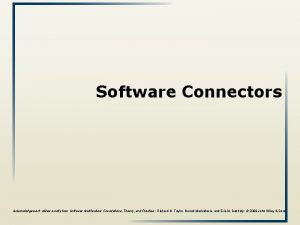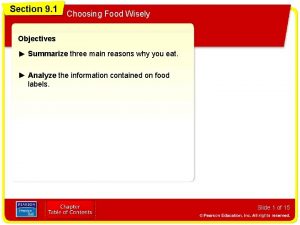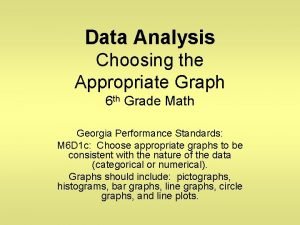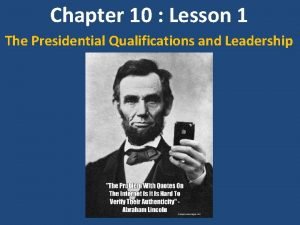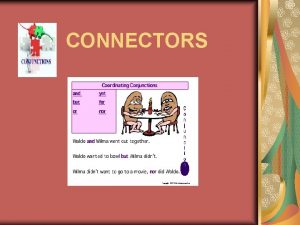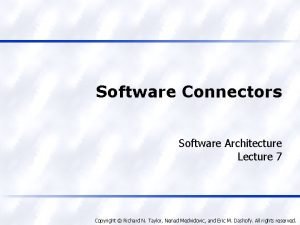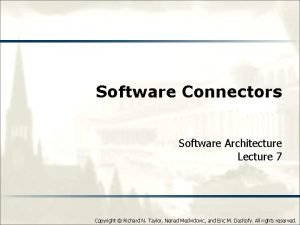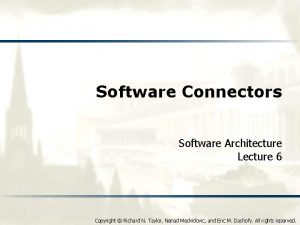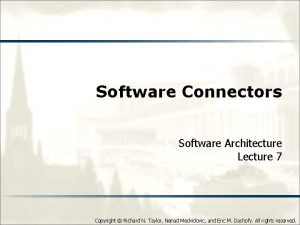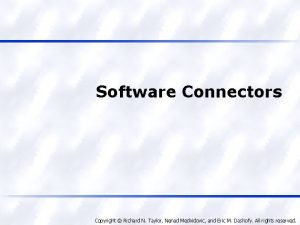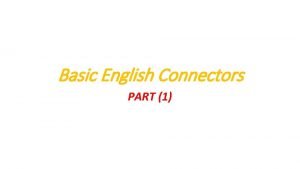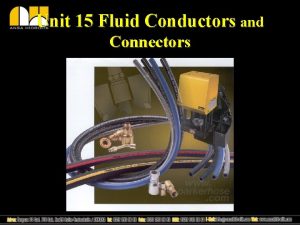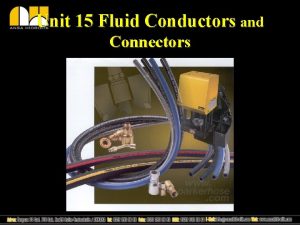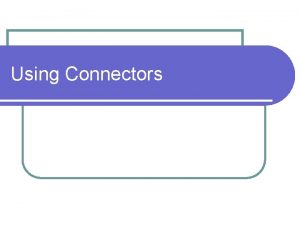Choosing Connectors Software Architecture Lecture 7 Copyright Richard




















- Slides: 20

Choosing Connectors Software Architecture Lecture 7 Copyright © Richard N. Taylor, Nenad Medvidovic, and Eric M. Dashofy. All rights reserved.

Software Architecture: Foundations, Theory, and Practice Role and Challenge of Software Connectors How do we enable Attach adapter to A or B“essence” B’s components A and B to Separate interact? Introduce intermediate form from its packaging Publish. Provide abstraction B with Transform on the converter fly import/export of A’s form Maintain multiple Negotiate to find is the right of to AWhat form for Aanswer? and BMake B multilingual Changeversions A’s form B’scommon form 2

Software Architecture: Foundations, Theory, and Practice How Does One Select a Connector? l l Determine a system’s interconnection and interaction needs u Software interconnection models can help Determine roles to be fulfilled by the system’s connectors u Communication, coordination, conversion, facilitation For each connector u Determine its appropriate type(s) u Determine its dimensions of interest u Select appropriate values for each dimension For multi-type, i. e. , composite connectors u Determine the atomic connector compatibilities 3

Software Architecture: Foundations, Theory, and Practice Simple Example l l l System components will execute in two processes on the same host u Mostly intra-process u Occasionally inter-process The interaction among the components is synchronous The components are primarily computation-intensive u There are some data storage needs, but those are secondary 4

Software Architecture: Foundations, Theory, and Practice Simple Example (cont’d) Ø Ø Ø Select procedure call connectors for intra-process interaction Combine procedure call connectors with distributor connectors for inter-process interaction Ø RPC Select the values for the different connector dimensions Ø What are the appropriate values? Ø What values are imposed by your favorite programming language(s)? 5

Software Architecture: Foundations, Theory, and Practice Procedure Call Connectors Revisited 6 Software Architecture: Foundations, Theory, and Practice ; Richard N. Taylor, Nenad Medvidovic, and Eric M. Dashofy; © 2008 John Wiley & Sons, Inc. Reprinted with permission.

Software Architecture: Foundations, Theory, and Practice Distributor Connectors Revisited 7 Software Architecture: Foundations, Theory, and Practice ; Richard N. Taylor, Nenad Medvidovic, and Eric M. Dashofy; © 2008 John Wiley & Sons, Inc. Reprinted with permission.

Software Architecture: Foundations, Theory, and Practice Two Connector Types in Tandem Select the appropriate values for PC and RPC! 8 Software Architecture: Foundations, Theory, and Practice ; Richard N. Taylor, Nenad Medvidovic, and Eric M. Dashofy; © 2008 John Wiley & Sons, Inc. Reprinted with permission.

Software Architecture: Foundations, Theory, and Practice Software Interconnection Models l l l Interconnection models (IM) as defined by Perry u Unit interconnection u Syntactic interconnection u Semantic interconnection All three are present in each system Are all equally appropriate at architectural level? 9

Software Architecture: Foundations, Theory, and Practice Unit Interconnection l l Defines relations between system’s units u Units are components (modules or files) u Basic unit relationship is dependency l Unit-IM = ({units}, {“depends on”}) Examples u Determining context of compilation l e. g. , C preprocessor l IM = ({files}, {“include”}) u Determining recompilation strategies l e. g. , Make facility l IM = ({compile_units}, {“depends on”, “has changed”}) u System modeling l e. g. , RCS, DVS, SCCS l IM = ({systems, files}, {“is composed of”}) 10

Software Architecture: Foundations, Theory, and Practice Unit Interconnection Characteristics l l l Coarse-grain interconnections u At level of entire components Interconnections are static Does not describe component interactions u Focus is exclusively on dependencies 11

Software Architecture: Foundations, Theory, and Practice Syntactic Interconnection l l Describes relations among syntactic elements of programming languages u Variable definition/use u Method definition/invocation l IM = ( {methods, types, variables, locations}, {“is def at”, “is set at”, “is used at”, “is del from”, “is changed to”, “is added to”}) Examples u Automated software change management l e. g. , Interlisp’s masterscope u Static analysis l e. g. , Detection of unreachable code by compilers u Smart recompilation l Changes inside unit recompilation of only the changes u System modeling l Finer level of granularity than unit-IM 12

Software Architecture: Foundations, Theory, and Practice Syntactic Interconnection Characteristics l l l Finer-grain interconnections u At level of individual syntactic objects Interconnections are static & dynamic Incomplete interconnection specification u Valid syntactic interconnections may not be allowed by semantics u Operation ordering, communication transactions l e. g. , Pop on an empty stack u Violation of (intended) operation semantics l e. g. , Trying to use calendar add operation to add integers 13

Software Architecture: Foundations, Theory, and Practice Semantic Interconnection l l l Expresses how system components are meant to be used u Component designers’ intentions Captures how system components are actually used u Component users’ (i. e. , system builders’) intention Interconnection semantics can be formally specified u Pre- & post-conditions u Dynamic interaction protocols (e. g. CSP, FSM) l IM = ({methods, types, variables, . . . , predicates}, {“is set at”, “is used at”, “calls”, “called by”, . . . , “satisfies”}) 14

Software Architecture: Foundations, Theory, and Practice Example of Semantic Interconnection connector Pipe = role Writer = write Writer П close role Reader = let Exit. Only = close in let Do. Read = (read Reader � read-eof Exit. Only) in Do. Read П Exit. Only glue = let Read. Only = Reader. read Read. Only � Reader. read-eof Reader. close � Reader. close in let Write. Only = Writer. write Write. Only � Writer. close in Writer. write glue � Reader. read glue � Writer. close Read. Only � Reader. close Write. Only 15 Software Architecture: Foundations, Theory, and Practice ; Richard N. Taylor, Nenad Medvidovic, and Eric M. Dashofy; © 2008 John Wiley & Sons, Inc. Reprinted with permission.

Software Architecture: Foundations, Theory, and Practice Semantic Interconnection Characteristics l l l Builds on syntactic interconnections Interconnections are static & dynamic Complete interconnection specification u Specifies both syntactic & semantic interconnection validity Necessary at level of architectures u Large components u Complex interactions u Heterogeneity u Component reuse What about ensuring other properties of interaction? u Robustness, reliability, security, availability, . . . 16

Software Architecture: Foundations, Theory, and Practice Composing Basic Connectors l l l In many systems a connector of multiple types may be required to service (a subset of) the components All connectors cannot be composed u Some are naturally interoperable u Some are incompatible u All are likely to require trade-offs The composition can be considered at the level of connector type dimensions and subdimensions 17

Software Architecture: Foundations, Theory, and Practice Connector Dimension Inter. Relationships l l Requires – u Choice of one dimension mandates the choice of another Prohibits – u Two dimensions can never be composed into a single connector Restricts – u Dimensions are not always required to be used together u Certain dimension combinations may be invalid Cautions – u Combinations may result in unstable or unreliable connectors 18

Software Architecture: Foundations, Theory, and Practice Dimension Inter-Relationships 19 Software Architecture: Foundations, Theory, and Practice ; Richard N. Taylor, Nenad Medvidovic, and Eric M. Dashofy; © 2008 John Wiley & Sons, Inc. Reprinted with permission.

Software Architecture: Foundations, Theory, and Practice Well Known Composite Connectors l l Grid connectors (e. g. , Globus) u Procedure call u Data access u Stream u Distributor Peer-to-peer connectors (e. g. , Bittorrent) u Arbitrator u Data access u Stream u Distributor Client-server connectors Event-based connectors 20
 Connectors in software architecture
Connectors in software architecture 01:640:244 lecture notes - lecture 15: plat, idah, farad
01:640:244 lecture notes - lecture 15: plat, idah, farad Looking for richard stream
Looking for richard stream Architecture business cycle activities
Architecture business cycle activities Call and return architecture in software engineering
Call and return architecture in software engineering Computer architecture lecture notes
Computer architecture lecture notes Isa definition computer
Isa definition computer Requirement analysis in software engineering notes
Requirement analysis in software engineering notes 4 ps of project management
4 ps of project management Lecture presentation software
Lecture presentation software Choosing foods wisely quiz
Choosing foods wisely quiz Choosing abstinence quiz
Choosing abstinence quiz Typical room height appropriate metric unit
Typical room height appropriate metric unit Lesson 25 choosing healthful foods
Lesson 25 choosing healthful foods 10 labour saving devices and their uses
10 labour saving devices and their uses 3 approaches to measuring performance
3 approaches to measuring performance Appropriate graph
Appropriate graph Brand elements transferability examples
Brand elements transferability examples Approaches to measuring performance
Approaches to measuring performance Lesson 1 presidential qualifications and leadership
Lesson 1 presidential qualifications and leadership Basic cooking techniques
Basic cooking techniques
